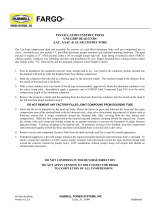Page is loading ...

© 2004 Hubbell Centralia, MO 65240 Printed in USA
Operation Instructions
for
Energized
Insulator Testers
Catalog No. System Application Voltage
C403-2298 Distribution through
deadend insulators 35kV
C403-2299 Transmission 44kV
suspension insulators through
500kV
NOTE: Because Hubbell has a policy of continuous product improvement, we
reserve the right to change design and specifications without notice.
P403-2297
12
Insulators Insulators
No. 2 & 4 No. 2 & 3
DAMAGED DAMAGED
The equipment covered in this manual should be used and serviced only by
competent personnel familiar with and following good work and safety prac-
tices. This equipment is for use by such personnel and is not intended as a
substitute for adequate training and experience in safe procedures for this
type of equipment.
These instructions neither cover all details or situations in equipment use nor
do they provide for every possible contingency to be encountered in relation
to installation, operation or maintenance. Should additional information and
details be desired or if situations arise which are not covered adequately for
the user’s purpose, the specifics should be referred to Chance.
Before operating a Chance Energized Insulator Tester, thoroughly read,
understand and follow these instructions.
Retain these instructions in the device case.
Insulators No. 2, 3 & 4
DAMAGED
NOTICE
▲
! CAUTION

Basic Design and Function
2
3
With an overhead circuit fully energized, a Chance tester can check the condition of
each insulator in a string. A sensitive voltmeter, the tester measures the difference
in potential across each insulator. Straight steel probes threaded into the two tester
forks contact the metal fittings on both ends of each insulator. (Activated by the
energized line, the meter requires only a small leakage current to make a reading.
Such a minimal load does not affect the relationship among readings for insulators
in the string.)
Readings taken on a string of three or more insulators produce a voltage-distribution
curve when plotted against their positions in the string.
In a string of all good
insulators, the insulator at the energized end will produce the highest reading. From
there toward the grounded end, the readings will decrease until the last insulator,
which normally is higher than the one next to it.
Variances from the “normal” characteristic curve shape indicate damaged
insulators which should be replaced.
1 Select tester model appropriate to system voltage:
Work Procedures
Note also, the two models’ full-scale maximums: Distribution model reads up to 11
kV; the Transmission model, up to 16 kV.
Distribution Tester
C403-2298
Transmission Tester
C403-2299
Model System Voltage
Distribution C403-2298 through 35 kV
Transmission C403-2299 44 kV Through 500 kV

4
5
2 Before and after each use, check meter and circuitry for proper operation with
a Chance Phasing Voltmeter Tester (PVT):
First, remove the plastic weatherseal from the jack behind the insulator Tester
meter. Into it, insert the PVT plug lead. Clip the other PVT lead to one of the
Insulator Tester probes.
Phasing Voltmeter
Tester C403-0838
3 Mount Insulator Tester on an insulated hot stick of proper length for system
voltage involved.
At all times maintain proper clearances from energized
line and components according to O.S.H.A. or your company rules,
whichever distances are greater.
Energized
(Conductor)
End
Polarity Switch
Grounded
(Structure)
End
Note the reading on the meter, flip the switch on the PVT to reverse the polarity and
note the reading again. Both readings should be within two graduations of each other
and in the upper part of the scale. Put the clip lead on the other probe and repeat this
procedure.
Replace the weatherseal plug in the meter jack.
Test across each insulator in the string and record the readings in order from
energized end to grounded end. To take a reading: Simply contact, at the same
time, both metal end fittings on an insulator with the two tester probes.

6
7
NOTE: These are examples only. The values plotted are not significant, but the curve
shapes are. These plots are given to illustrate how to locate damaged insulators by
deviations from the “normal” (or characteristic) curve shape.
(See following pages for more test examples.)
Sample All
Test Insulators
Grid OK
“Normal”
Voltage
Distribution
Curve Shape
4 Plot a graph of the readings to detect any insulator(s) which should be replaced
as indicated by the following guidelines.
Do not expect a zero reading to identify every defective unit.
Even if punctured,
an insulator probably will not be shorted completely and some voltage still will pass
across it.
Consider as damaged any insulator which produces a reading 30% or more
below the characteristic curve shape established by others in the string.
In the case of one defective unit,
the other insulators’ readings increase to
compensate, shifting the curve to higher values.
In the case of multiple defective units,
comparing readings to a reference curve
previously developed from a string with all good insulators provides the best means
for interpretation.

8
9
Insulator Insulator
No. 1 No. 2
DAMAGED DAMAGED
Sample Test Grid
Insulator Insulator
No. 3 No. 4
DAMAGED DAMAGED
“Normal”
Voltage
Distribution
Curve Shape
ALL insulators test OK
Tester Reading, kV
Tester Reading, kV

Insulators Insulators
No. 1 & 2 No. 1 & 3
DAMAGED DAMAGED
Insulator No. 4
DAMAGED
Insulators Insulators
No. 1 & 4 No. 3 & 4
DAMAGED DAMAGED
Insulator No. 2
DAMAGED
10 11
/



